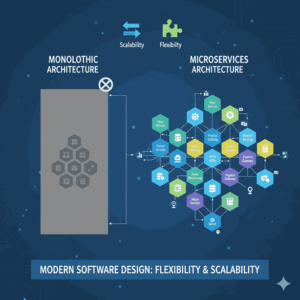Microservices Architecture is a prevalent technique to design big and complicated apps these days. In the past, programs were developed using monolithic architectures, which meant that all the parts were put together as one enormous unit. Microservices are distinct because they break an app up into a lot of little, discrete services wherein an individual may create, update, and use each service available on its own, which each one does have one unique job. This approach makes adding of new features, fixing bugs, and maintaining software easier. It also makes it more dependable and adaptable. We can learn about how modern web apps are constructed and kept up by learning about microservices.
Important Ideas About Microservices

Freedom and Independence
The most significant thing about microservices is that each one can run on its own. Each service has its own code and data, and a certain group of developers is in charge of it. With this setup, you may update or fix one service without having to change the whole system. For instance, when scrolling on online shopping site, from login, unto listing of products to checkout procedure could all work as separate services. This type of organization, helps in speeding up the work completion as it allows many teams to work on the same thing simultaneously. Additionally, this keeps the system stable due to the other services that can keep working normally even if one of them malfunctions.
Information and Communication
Instead of sharing one enormous database, each microservice has its own data. This can make it harder to manage data, but it also provides you greater options. Every service can pick the kind of database that works best for them. A payment service, for instance, can utilize a structured relational database, while a user profile service can use a flexible NoSQL database. APIs are simple connectors that let the services talk to each other. This way of completing works keeps services unique, allowing development and growth without relying on each other too much.
Advantages and Disadvantages
Microservices make it simple for apps to grow. If a portion of the system, like a search tool, is used a lot, only that part needs to get bigger. This saves time and computing resources. Microservices are also good at not failing. The other services can still work even if one of them breaks. For example, if the service that suggests products fails, users can still look at items and finalize their purchases.
But this system also has certain problems. Managing many different services and making sure of the accuracy of data across all the services must be challenging where you’ll be needing effective tools to keep an eye on them and solve the problems. This can occasionally slow things down since services talk to each other over a network. To avoid these problems, developers need to prepare ahead.
Final Words
Microservices Architecture has altered the way programmers make software for the web. It emphasizes on making a lot of little bits that can operate together but stay separate. This method makes it easier to update programs, makes them expand faster, and makes them more stable when problems happen. Even if it has some problems, the benefits make it a top choice for many businesses today. Microservices are an example of how software architecture is moving toward systems that are modular, adaptable, and ready for the future.
Code smarter—integrate with ease.



